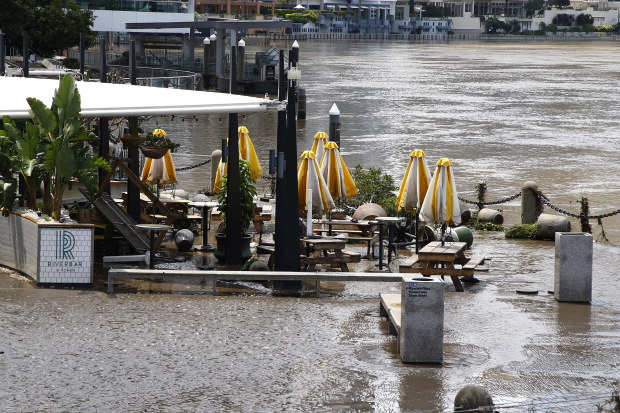Insurers warn of cutting flood cover options or even customers
Key Points
- The federal parliament is examining insurance and flooding.
- Some insurers are cutting customers, or dropping some special cover.
- Insurers also noted customers being more willing to take on risk themselves.
Insurers are warning of cutting some types of flood cover and even dumping certain customers following the devastating inundation that struck Australia last year.
Policyholders are also increasingly not renewing cover amid cost-of-living pressures and spiralling premiums, and others were wearing more risk themselves to keep their insurance costs down, the companies warned.

Brisbane’s business lunch zone Eagle Street was inundated during the 2022 floods. Tertius Pickard
The details were provided in submissions to a federal parliamentary inquiry into last year’s devastating floods.
The biggest flood was in Queensland and NSW from February last year which caused more than $6 billion in insurance claims. Other inundation includes Victorian, Tasmanian and NSW floods in October that cost another $781 million in claims, according to Insurance Council of Australia data.
Major insurers have filed submissions for the inquiry determining how they handled claims. Already the sector had front-run some of the problems, delivering their own assessments in an industry-commissioned Deloitte report in October that told of failing to scenario-plan such a large event or communication breakdowns.
But some of the submissions to the federal inquiry reveal changes in coverage and potential offerings.
Key among the differences was Allianz, one of the few major insurance brands that offers customers the option of whether they want flood cover, which can be costly.
Many major brands make flood cover compulsory following the public backlash against industry definitions after the 2011 inundation, when some people assumed they had flood protection found out they were only covered for stormwater.
But Allianz, part of the larger German-based insurer, appears to have suffered again a sting in disputes with customers in this latest flooding last year.
Of 36,022 customer claims from the disasters, 725, or 2 per cent, were refused due to a lack of flood cover, Allianz said.
“Given the heightened complexity of managing claims for customers without flood cover, and the customer experience throughout the 2022 floods, Allianz is reviewing our customer choice flood cover model including considering moving to mandatory flood cover,” it said.
Another option was offering “innovative product solutions” for customers exposed to flood risk, it said. A source with knowledge of considerations said options could include cover based on certain events, such as river heights, or perhaps setting lower limited payouts combining either flood or stormwater cover, theoretically avoiding definitional fights over where the inundation came from.
Caravan insurance ‘unsustainable’
Brisbane-based Suncorp’s submission revealed it had cut two types of caravan and RV insurance from last month, related to relocatable homes and onsite caravans. These lines of business were “unsustainable due to the high proportion of risks being located in caravan parks prone to flooding”.
Many insurers said they were still willing to renew home insurance customer holders if they had made a flood claim, albeit the pricing would reflect the risk.
But Sunshine Coast-based Youi, known in the industry for wanting lower-risk customers, admitted to declining to offer renewals in 112 cases after households had made a claim from last year’s flooding. “This [was] primarily because Youi have updated information about elevated flood risk in relation to those individual addresses,” it told the inquiry.
Youi’s submission also pointed to worrying trends about under-insurance, saying people not renewing when offered cover had accelerated from August last year following “a period of higher year-on-year premium increases necessitated by increased claims and reinsurance input costs”.
Higher excess levels
Youi similarly noted a marked increase in customers were renewing at higher excess levels – the amount of damage bill a customer pays themselves before insurance is triggered. “Increasing the excess reduces the value of the renewal offer premium and is often a choice made by customers motivated to reduce their renewal premiums,” it said.
Brisbane-based RACQ also noted a reduction in take-up of insurance to protect home contents “as economic pressures coincide with insurance premiums increasing”, along with people also stretching out their excess levels.
Sydney-based IAG, whose brands include NRMA, was highly sensitive with information compared to other insurers. Details such as average time taken to provide payouts or how many claims were refused due to not having flood cover, were only supplied confidentially to the inquiry.
Insurers again pushed governments to drop certain taxes or consider mitigation measures, such as zoning for where homes could be developed.
Introducing your Newsfeed
Follow the topics, people and companies that matter to you.
Find out moreRead More
Latest In Infrastructure
Fetching latest articles